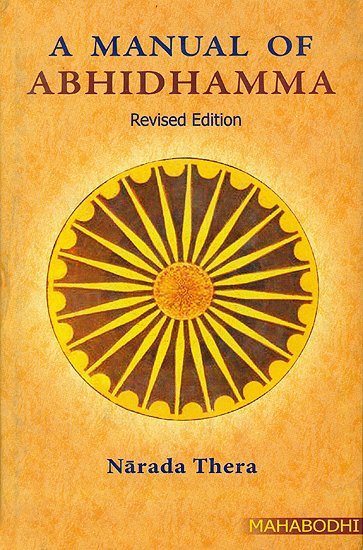A Manual of Abhidhamma
by Nārada Thera | 80,494 words | ISBN-13: 9789380336510
In the Abhidhammattha Sangaha there is a brief exposition of the Law of Dependent Origination, followed by a descriptive account of the Causal Relations that finds no parallel in any other philosophy. Edited in the original Pali Text with English Translation and Explanatory Notes by Narada Maha Thera....
§ 9.
Phalasamāpattivīthiyam pan'ettha sabbesam piyathāsakaphalavasena sādhāranā'va. Nirodhasamā pattisamāpajjanam pana anāgāminañ c'eva arahattānañ ca labbhati.
Tattha yathākkamam pathamajjhānādiMahāggatasamāpattim samāpajjitvā vutthāya tattha gate sankhāradhamme tatthatatth'eva vipassanto yāva ākiñcaññāyatanamgantvā tato param adhittheyyādikam pubbakiccam katvā n'eva saññā n'āsaññāyatanam samapajjati. Tassa dvinnam appanājavanānam parato vocchijjāti cittasantati. Tato nirodhasamāpanno hoti.
Vutthānakāle pana anāgāmino anāgāmiphalacittam arahato arahattaphalacittam ekavāram pavattitvā bhavangapāto hoti. Tato param paccavekkhanañānam pavattati.
Ayam ettha samāpattibhedo.
Nitthito ca vipassanākammatthānanayo.
Bhāvetabbam pan'icc'evam bhāvanādvayam uttamam
Patipattirasassādam patthayantena sāsane.
Iti Abhidhammattha Sangahe Kammatthānasangaha-Vibhāgo nāma navamo paricchedo.
(translation)
§ 9.
Herein 'the Attainment to Fruition' is common to all in accordance with their respective fruits. But 'the Attainment to Cessation (56) is possible only to Never-Returners and Arahats.
In this case, one attains successively to the great ecstasies like the first jhāna, etc., and emerging therefrom contemplates on the conditioned things in each of those jhānas. Thus he proceeds up to 'the State of Nothingness'. Then, having attended to the preliminary duties such as resolving, etc., he attains to the state of Neither-Perception nor Non-Perception'. Now after two ecstatic javana thought-moments his stream of consciousness is suspended. Thereafter he attains to (Supreme) 'Cessation'.
At the time of rising, if to a Never-Returner, an Anāgāmi Fruit consciousness or to an Arahat, an Arahat Fruit consciousness, occurs only for a single moment and then lapses into bhavanga. This is followed by the knowledge of reflection.
Herein this is the Section on Attainments. The end of exercises on mental culture or Insight. One who wishes to enjoy the essence of practice in this Dispensation should thus develop the sublime dual meditation.
This is the ninth chapter of the Compendium of Abhidhamma which deals with the Exercise on Meditation.
Notes:
56. Nirodhasamāpatti - Lit., 'attainment to cessation'. It is so called because during this period the stream of consciousness temporarily ceases to flow. Mind is suspended, but vitality persists.
It is only an Anāgāmi or an Arahat who has developed the rūpa and arūpajhānas who can attain to this supreme state of ecstasy. When such a person wishes to attain to nirodhasamāpatti, he first attains to the first jhāna and, emerging from it, he meditates on the transiency, sorrowfulness, and soullessness of conditioned states found in that particular jhāna. Likewise, he attains, in order, to the remaining jhānas and meditates in the same way until the arūpaj jhāna of 'Nothingness'.
Emerging from this jhāna, he makes the following four resolutions:
- that his fourfold requisites be not destroyed
- that he should arise in time when his services are needed by the Sangha
- that he should arise in time when he is summoned by the Buddha
- whether he will live for more than seven days from that moment
He has to think of his age-limit as this ecstatic state normally extends to seven days.
After making these resolutions, he attains to the last arūpaj jhāna of 'Neither Perception nor Non-Perception', and remains in that state for two javana thought moments. Immediately after, he attains to nirodha-samāpatti when his stream of consciousness, is temporarily suspended. After seven days he emerges from this state and experiences for a single moment an Anāgāmi Phala consciousness in the case of an Anāgāmi, or an Arahat Phala consciousness in the case of an Arahat. Thereafter arises the bhavanga citta.
For details see Visuddhi-Magga.
Footnotes and references:
[1]:
These nine kinds of Insight - namely, udaya, vaya, bhanga, bhaya, ādīnava, nibbidā, muñcitukamyatā, patisankhā, upekkhā ñānas are collectively termed patipadāñānadassanavisuddhi and anuloma - Purity of Vision in discerning the method the sixth number of the Path of Purity.
[2]:
Insight found in this supramundane Path Consciousness is known as nānadassanavisuddhi - Purity of Vision regarding intuitive wisdom, the seventh member of the Path of Purity.
